







A time of change is upon us, like none we have seen for generations. A time of vulnerability, but also opportunity too. In this episode of Visual Friends Radio, we’re joined by Marcel van Hove and Danny Low of the Visual Friends team to talk about how they’re focusing on adaptability, innovation and channelling their creative power during the current pandemic.

Over a decade ago Charity watched a team of consultants at an offsite event create awe-inspiring visual content. She dreamed that one day she too could communicate with simple visuals from words but had no idea how to get there. Flash forward 10 years to discovering Visual Friends, bikablo and her journey has begun.


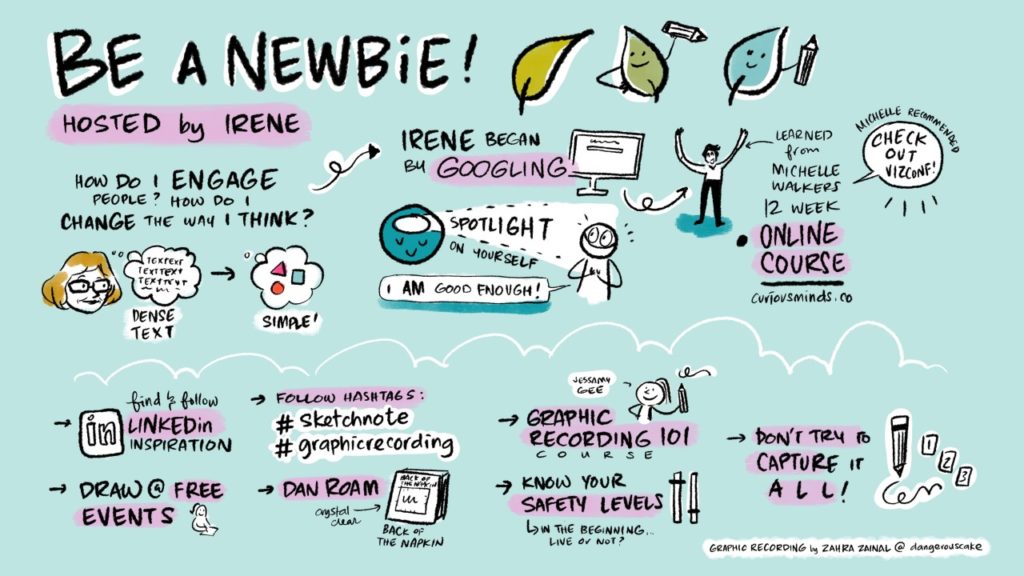
During the VizConf 2019 OpenSpace planning, when participants advertised their sessions and everyone voted for the ones they were interested in, collaboratively creating the daily agenda, a petite woman in her 50s came to the front. She smiled and said she wanted to lead a session on “How to be a newbie”. My heart sunk. I thought that after ‘serious’ topics like “Lettering for Lefties”, “Visualisation in Education”, and “Digital Scribing”, that we already had on the board, no one would want to hear her speak.
How wrong was I. Nearly every hand in the room shot up? “Being a newbie” was one of our most popular sessions that day. We talked about how hard it is to start something new and what resources, tools and tricks one can employ to help visualisation progress.
Plato said, “The beginning is the most important part of the work”. It is also often the hardest.
With the first month of 2020 over, have you begun taking steps towards being a more confident visual practitioner? Whether you are a professional or a complete amateur, becoming better at any aspect of visualisation begins with the single first step.
So, here are just a few “newbie” suggestions to help you start building your
visualisation muscles this year.
And the best bit? You can start making plans for 2020 visually. Grab a piece of paper, a marker and draw your visualisation journey for 2020.
If you need help – join our free video training here or ask for a visual career coaching session with Marcel here.
All you need to do is simply begin, and before you know it, you’ll no longer be a newbie.
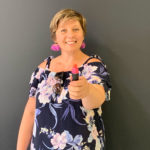
The article was written by Natalia Tsygankova. Natalia has always loved words and talking to people. She has put that passion to good use and has been sharing people’s stories in the community radio, TV and print media for the last 10 years. Natalia is also a big fan of true storytelling events and regularly volunteers at the most famous one – The Moth, interviewing the winner. You can hear her own story of moving to Australia from Russia in 1999 here. Natalia believes that everyone has a story – So what’s yours? Contact her today to share your story.


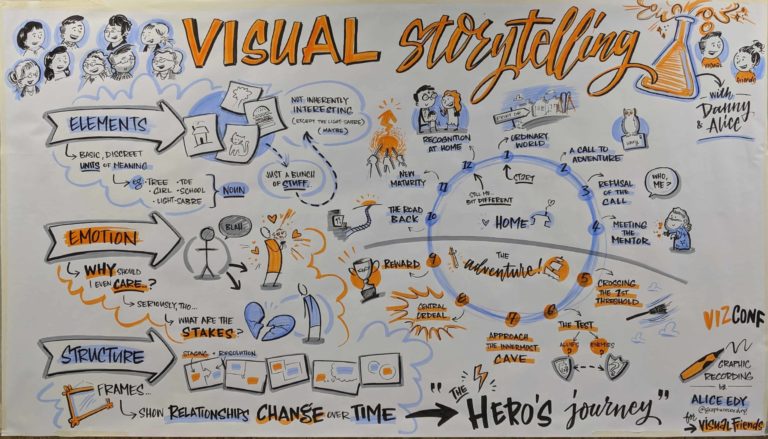
Last weekend my family and I put together the very first furniture items in our new home after moving overseas – an Ikea table and four chairs. After eating on boxes for a week, we couldn’t wait. The four of us, including a 6-year-old, a 10-year-old and two adults in their 40s assembled everything in under an hour using only one allen key and a set of drawings.
If you look around your home, chances are, you’ll spot at least one Ikea item you assembled yourself. Stressful as it can be, (i.e. where the heck does this go??), imagine if you had to deal with a long list of instructions instead of simple drawings.
It’s a well-known fact that most of us prefer to consume information visually. According to the study republished by Forbes, “91% of consumers now prefer visual and interactive content over traditional media.”
But did you also know that people can follow instructions 323% better when visuals are used? That’s because our brain is so much better at dealing with images than text. According to MIT researchers, the human brain is capable of processing an image in as little as 13 milliseconds. The blink of an eye takes about 300 milliseconds.
Though nowadays, visuals alone won’t do the trick anymore. It’s more about what you do with them, which is where visual storytelling comes in.
As overused as this term might seem, it’s not just a buzzword. Using a series of drawings to create a narrative for a specific purpose – to record, to communicate, to engage, to influence – has been around for centuries.
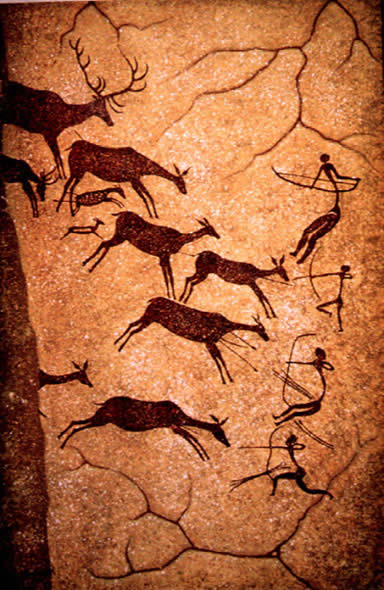

It is still the most powerful way to put ideas into the world today.
Visual storytelling has become a trend for the majority of brands since 2016. Visual narratives with an accent on relevance and emotions are now part of every big brand’s marketing.
In organisations, visual storytelling is increasingly used as a way to support transparency and mutual understanding of systems and processes, for example, development of ‘customer journeys’, large scale ‘strategic visualisations’ and even ‘design thinking’.
Telling curated stories visually through photos, videos, comics and infographics (the most shared content on the web) is currently the most direct way to connect with your customers, your team or your stakeholders.
In a nutshell, visually storytelling seems easy – pick your content, line up visuals and off you go.
But to do it well, to do it effectively, you need to understand the specific storytelling techniques and develop a different set of skills.
That’s why the Global Bikablo Team created the advanced bikablo training covering popular topics like ‘Visual Storytelling’ and “Graphic Scribing’, which began its roll out world-wide in 2020.
During the two days of training the students, who have already learnt the basic visualisation principles during the bikablo fundamentals course, learn how to transform complex subjects into lively picture stories. With the bikablo emotions figures, large-format layout techniques and visual dramatic composition, students are taught to convey necessary messages in a clear, but more emotional and lively way.
Our Brisbane based trainer Danny Low attended the Global bikablo train-the-trainer course last year in Germany and is now the only certified instructor to teach advanced bikablo in Australia and NZ. “The course, with the focus on visual storytelling for business, allows you to take your visual skills to the next level. We teach people the theory behind the visual storytelling, how to create visual hierarchy, the most effective ways to layout and present the content on paper. This is the deep knowledge that has been packaged into a time-effective workshop on the hottest visualisation topics.”
Last year at VizConf, (Australia’s premier and only conference for visual practitioners), we trialled the advanced class with a small group of participants.
Sujith Ramachandra, a Senior Consultant at Radically, and one of our enthusiastic students had an opportunity to attend the session. “The pace of the course, the balance of theory and practice was fantastic and I came out with a lot to think about and a boost of energy and confidence. Visualization with clarity and awareness of the power of storytelling is a game-changer.”
Watch out for the advanced bikablo classes on our website or contact us to arrange an in-house session (if your team has already completed bikablo fundamentals).

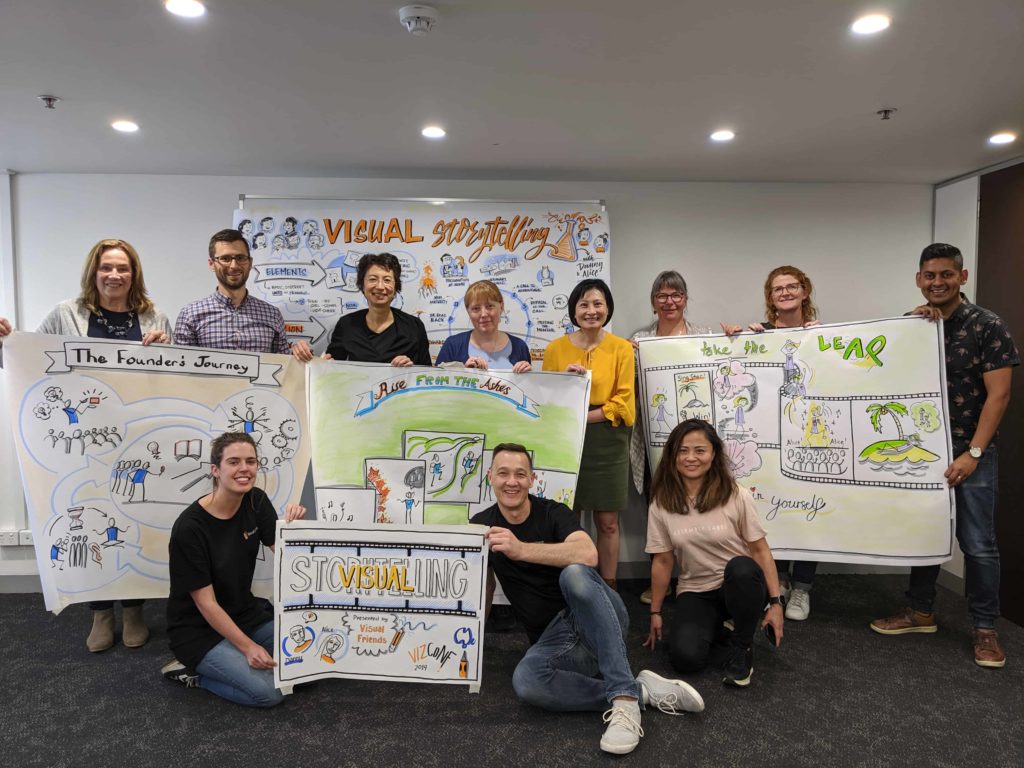

The article was written by Natalia Tsygankova. Natalia has always loved words and talking to people. She has put that passion to good use and has been sharing people’s stories in the community radio, TV and print media for the last 10 years. Natalia is also a big fan of true storytelling events and regularly volunteers at the most famous one – The Moth, interviewing the winner. You can hear her own story of moving to Australia from Russia in 1999 here. Natalia believes that everyone has a story – So what’s yours? Contact her today to share your story.


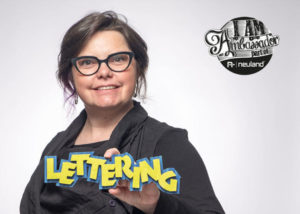
Founder of Let's Letter Together!
A couple of words about Heather Martinez. Heather likes to live in the mountain valley of Durango, Colorado. Heather is a visual practitioner and also an ‘Agile guy’ like me or Danny. She spends a lot of her time running virtual lettering classes for visual practitioners on LetsLetterTogether.com where you can improve your lettering skills on a 1:1 based via Zoom. Additionally, she will be offering 2 online courses associated with her new book and a virtual version of her in-person workshop: Level Up Your Lettering starting in the spring. In parallel, she runs her coaching practice where she offers life and art life coaching to artists. Here Heather believes that everyone can become an artist!
We talk about her whole life from the beginning where she grew up, where she chose to live and how she got into graphic facilitation. We learn how it feels being graphically recorded for the first time herself and what we as graphic recorders might need to consider when recording someone talk.
Last but not least, we talk about her new book which will have the title the ‘Lettering Journey’. It’s based on a cross-country road trip she took after leaving Washington, DC. She has a great plan for how she will create her next book: She travels and teaches lettering across Europe over the next 2 months. While all of her workshops have filled, she will offer an additional 1-day Lettering tour in each city. She will take the participants out of the training room into the environment, walk the streets and look for lettering styles they can break down and use in their work at the wall. The “tradecraft” of lettering will be covered, including how to find inspiration in your environment and how to break down each style into the strokes and tools used. Please have a look at her travel schedule here:
Lettering Tours:
Other locations may include:
Other upcoming workshops:
Now you might think Europe is far away and I can’t travel right now! – Here we are delighted that Heather has confirmed to be our keynote speaker for VizConf 2019. Additionally, she will also run a pre-conference course about lettering the day before VizConf and might even take everyone on a lettering tour through Melbourne.
Stay tuned and make sure you get your Visual Friends newsletter updates so that you don’t miss the spot in her class.

Marcel combines agile team coaching with visual thinking. Marcel believes that a group of people drawing together on a whiteboard can change the world. He loves high-performing teams and therefore coaches teams every day.


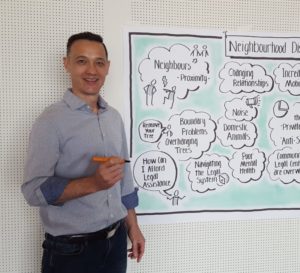
Trainer & Partner at Visual Friends
Let me introduce to you Danny Low. Danny is not only a bikablo® trainer and partner at the Visual Friends. He is also a very good friend of mine and in many ways, we are very similar. We talk a bit about that but we forgot to talk about one great story. So in the early days when I met Danny, he told me that he will take time off and travel with his family around the world.
He told me that he would like to pass on some of the experiences he and his wife Anna had and to show the kids the world. With that, we pretty much hit the core DNA of Danny. He likes to pass on his life experience to others – not only to his kids but also to his students at the Visual Friends. He likes to help others and is a great mate that everyone would like to have as a friend. We follow his personal journey, learn how to visualise legal contracts, hear about project management, agile coaching and how he became part of the Visual Friends. For me, Danny’s story is another great example of what can happen in life when you follow your passion and make a couple of choices at the right time. Please welcome our lawyer and Kung-Fu master Danny Low from Brisbane.

Marcel combines agile team coaching with visual thinking. Marcel believes that a group of people drawing together on a whiteboard can change the world. He loves high-performing teams and therefore coaches teams every day.


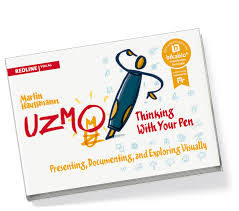
Presenting, Documenting and Exploring Visually
At the start of every bikablo® basics class, we talk about what bikablo is and how it is different. Most people who attend our classes have ‘no drawing skills’ and are worried about their lack of drawing ability. At the end of two days, they are consistently surprised with the dramatic change in their ability to visualise. The reason for these results is that bikablo is a systematic approach to visualisation. In bikablo, we say that ‘visualisation is not about art, it’s about language’. And just like any language, the goal is about communicating meaning. All languages do this because they have systematic grammar, syntax and cultural nuances that allow people to have shared understanding of what is being communicated. Just like the languages we speak in, bikablo is a systematic visual language. It has letters, words, grammar and syntax that can be combined and recombined in different ways in order to communicate content in a way that is meaningful to its audience and their surrounding context.
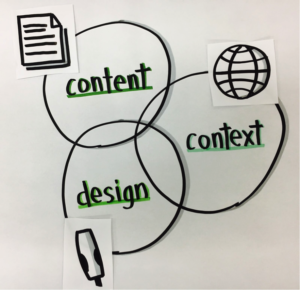

In his book, ‘UZMO’, bikablo co-founder Martin Haussmann provides a simple but very powerful framework for understanding, and using, visualisation as a language. It has three basic elements, that I like to represent as a Venn Diagram:
When I communicate this idea at the beginning of a class, it’s always greeted with a few nods and a few puzzled expressions. But as we gradually build in each layer of the technique and apply it in practice, I return to this framework as a way to plan and then execute our visualisations. Through this journey of theory and practical experience, the penny drops on what this framework means and how it can be used in practice. Let me give you a simple example of how I used this recently.
I was designing a 2-hr class on how to design and facilitate collaborative meetings and workshops. There would be 32 students who were coming after work and would be seated in a ‘cosy’ classroom for 2-hours. My presentation was largely based on a slide deck I had created but was organised around two frameworks that would gradually be revealed. The students would need to hold the frameworks in their mind as we progressed through the slide deck. I would need to be able to refer back to the frameworks throughout the class. I needed to create ‘signposts’ for each part of my content that would help the group remember the frameworks as I talked to them. I also needed people to be able to see the signposts from the back of the room.
Finally, this was a class that I planned to offer multiple times, so I needed re-usable content.
The 5 key jobs of a facilitator
The 5 key design elements of any collaboration session
Overall there were are two frameworks each with elements, so 10 content elements overall.

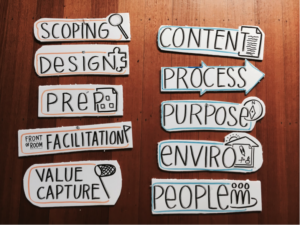
As you can see from the images, I created 10 physical signposts which we call ‘mobile elements’ in bikablo®. I used bold, visible lettering with an icon or container around each to anchor the meaning of each piece of content. I also used two different colours to delineate the two different frameworks. I used foam board (or foam core) for two reasons. Firstly because its smooth white surface really takes well to markers without bleeding. Secondly it is a light, stiff and relatively durable material which would last longer with repeated use.
This is a simple example, but the framework is scalable to larger, more complicated visualisations, and indeed, to any form of design work more generally that involves content that must be communicated in a way that can be interpreted in a way that fits a particular context.
Join us at one of our upcoming 2-day classes to learn more about this framework and how to use it in practice.

The article was written by Natalia Tsygankova. Natalia has always loved words and talking to people. She has put that passion to good use and has been sharing people’s stories in the community radio, TV and print media for the last 10 years. Natalia is also a big fan of true storytelling events and regularly volunteers at the most famous one – The Moth, interviewing the winner. You can hear her own story of moving to Australia from Russia in 1999 here. Natalia believes that everyone has a story – So what’s yours? Contact her today to share your story.



Co-Founder Visual Friends
To understand what bikablo® means we need to go back almost 10 years. When a company — actually a consultancy from Cologne stated their first product and this company was called, it’s still around, of course, Kommunikationslotsen, it’s quite hard to pronounce I know. It means actually communication pilot.
So it’s a consultancy that works on a holistically approach to help companies to change, to go through change phases. The Kommunikationslotsen is one of the first companies in Germany who actually started with visual facilitation and they created a product which is like a pad of picture cards.
Let’s write that down. So they built this product which was like a visual dictionary and it was basically a collection of picture cards. Those picture cards were mounted together like you see here to a block. Have a look.
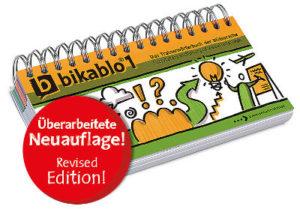

1st Bikablo Book
Bestselling original visual dictionary is a concise easy-to-use reference book that will guide you into the world of visual facilitation with hundreds of brilliant picture symbols. So it looks like this and you can still order it, and it’s still very valid because pictures don’t change so much. Like, you have a good dictionary in there. Right, and if you see that picture card pad, if we underline the first two letters here you would come up with a funny English term, it would be pi-ca-pa.
Okay, but the words in German they start with bild for pictures and cards we have karte and for pad we have the word block, which is similar to an English word.
So picture card block was actually here the first two letters, and that’s how the word bikablo® came up as the brand based on the first product they created. Right, but today bikablo® is much more than just this one visual dictionary.
Just recently we opened up the bikablo® academy, which is the worldwide head organisation for the bikablo® trainings. The bikablo® academy provides a training program which is quite different to many others.
We provide a very systematical approach to drawing. So you don’t need to draw a straight line to come to the training. We actually teach you how to hold the pen, how to draw a straight line without a ruler and just get this out of the pen. First thing in the morning we do together. All right. So let’s capture that.
We provide a systematical approach to drawing, and if you like, there is an early bird available and you can join in either in Sydney or Melbourne. There is London coming up and everywhere in the German-speaking areas as well.

The article was written by Natalia Tsygankova. Natalia has always loved words and talking to people. She has put that passion to good use and has been sharing people’s stories in the community radio, TV and print media for the last 10 years. Natalia is also a big fan of true storytelling events and regularly volunteers at the most famous one – The Moth, interviewing the winner. You can hear her own story of moving to Australia from Russia in 1999 here. Natalia believes that everyone has a story – So what’s yours? Contact her today to share your story.


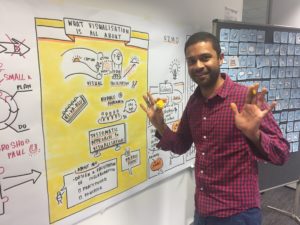
Facilitator, Educator, Designer, Coach / Co-author, Collaboration by Design
I think I have to confess something to you guys. April this year I recorded an amazing podcast with John Hibble about his venture, The Facilitation Starter. John Hibble is an experienced facilitator with more than 10 years in the field.
After I recorded this podcast in April my life became quite busy as I started building a house in May and had a newborn baby in July. That is the reason why this podcast stayed on my hard drive for quite a while. Now it’s time to unveil this great conversation about workshop preparation from the session designed over delivering a workshop to how you capture insights.
Over the last month, things have changed slightly. I’m very happy to announce that John is also now a certified bikablo® trainer like Martin and me, and together we run as the Visual Friends bikablo® training in Australia and New Zealand.
Now let’s do the time travel and go back to April and listen to John Hibble from the Visual Friends Team.

Marcel combines agile team coaching with visual thinking. Marcel believes that a group of people drawing together on a whiteboard can change the world. He loves high-performing teams and therefore coaches teams every day.

Carola Keitel and Frank Wesseler are an amazing team. They met through the bikablo® Akademie in Cologne and became a couple. Carola always had the idea of travelling the US and maybe working there one day. So when she met Frank they put their energy together as a couple and made it possible. For me, this is an amazing story where you can see what a couple can do when they combine their strength and make things happen.
In the interview, we talk about it in detail. How it all started with a vague idea. How the things then came together and have a look at their travel plan. After the IFVP conference in Decatur, they travel from the east coast to the west coast and run 7 training in 10 weeks. It is an exciting trip from the east to the west and I can’t wait to introduce to you now Carola and Frank from the bikablo® Akademie in Cologne.
Have a look at their travel plan:

Marcel combines agile team coaching with visual thinking. Marcel believes that a group of people drawing together on a whiteboard can change the world. He loves high-performing teams and therefore coaches teams every day.



Co-Founder Brainmates
Today I talk to Nick Coster. Nick founded Brainmates together with his wife Adrienne Tan more then 12 year ago. Brainmates is one of those companies who are not very big but very professional. Their special field is product management. We talk about the evolution of product management. How the role of product management evolves when the organisation scales up and the CEO can’t be the product manager anymore.
Nick describes the role of a product manager as the chief storyteller in a company. The product manager is the CEO of a product but normally doesn’t have the same authority as the CEO. He needs to take everyone on the journey and explain the challenges ahead of the product. Storytelling is the key to this way of leadership and visual storytelling is the lasting version of it as you can capture the visualisation of the story in photos and videos. Therefore I am very excited to announce that we will run the bikablo® Visual Storytelling (bikablo Advanced) class in Australia shortly before Christmas.
Many of my bikablo® visual facilitation students are in a role around requirements gathering or are working in a business analyst role. In this interview, I put myself in the role of a business analyst and ask myself how could I become a great product manager. What does it take to become that person and what do I have to learn on the way.
Being on the product management journey alone can be quite challenging. It’s much better to go the way together and catch up with mates who are in a similar role as you. I would like to highlight the “Leading the Product Conference” run by Brainmates every year. The conference will be held this year on the 20th of October in Melbourne and 25th in Sydney. Check it out and I hope to see you around in one of the next bikablo® visualisation training.

Marcel combines agile team coaching with visual thinking. Marcel believes that a group of people drawing together on a whiteboard can change the world. He loves high-performing teams and therefore coaches teams every day.

